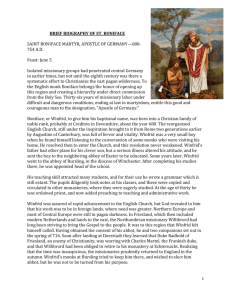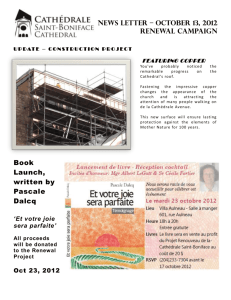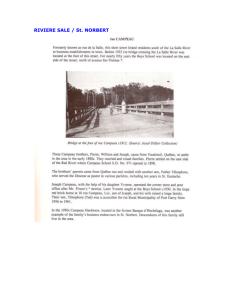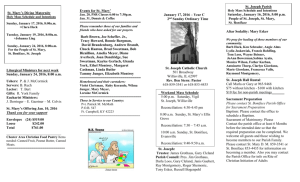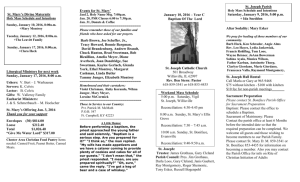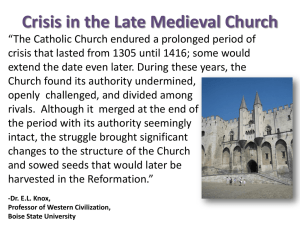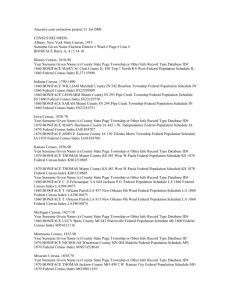Worksheet over Letters of St. Boniface & Bio of St Lioba
advertisement
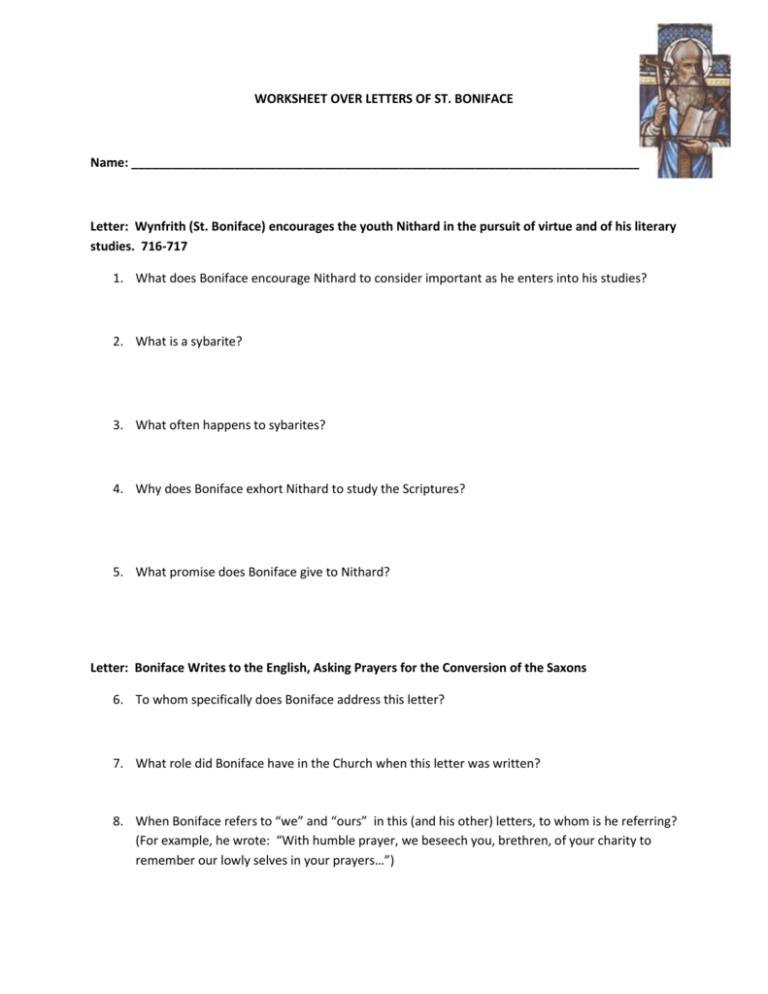
WORKSHEET OVER LETTERS OF ST. BONIFACE Name: _______________________________________________________________________________ Letter: Wynfrith (St. Boniface) encourages the youth Nithard in the pursuit of virtue and of his literary studies. 716-717 1. What does Boniface encourage Nithard to consider important as he enters into his studies? 2. What is a sybarite? 3. What often happens to sybarites? 4. Why does Boniface exhort Nithard to study the Scriptures? 5. What promise does Boniface give to Nithard? Letter: Boniface Writes to the English, Asking Prayers for the Conversion of the Saxons 6. To whom specifically does Boniface address this letter? 7. What role did Boniface have in the Church when this letter was written? 8. When Boniface refers to “we” and “ours” in this (and his other) letters, to whom is he referring? (For example, he wrote: “With humble prayer, we beseech you, brethren, of your charity to remember our lowly selves in your prayers…”) 9. Why is he writing these people? Boniface Asks Protection for His Mission In Thuringia From Grifo, Mayor of The Palace 10. What famous men of history are related to Grifo? 11. What role did Grifo have during the time this letter was written? 12. What does Boniface ask of Grifo? 13. How should Grifo conduct himself? Letter XIII, To the Holy Virgin and Dear Lady Eadburga 14. Boniface wrote this letter to describe a mystical experience of a certain religious brother. Briefly explain what happened to him. Boniface Thanks Abbess Eadburga for Sending Him Books 15. Boniface asks Abbess Eadburga to pray for him. Why? DO THE FOLLOWING ON A SEPARATE SHEET OF PAPER. STAPLE IT WITH THIS SHEET AND SUBMIT: To his friend in the embrace of loving arms, his brother in the bonds of spiritual brotherhood, Archbishop Egbert 16. Boniface is facing a difficult situation and is struggling with how to handle it. He writes Archbishop Egbert for advice. Pretend you are the Archbishop and write a response to Boniface (5-7 sentences). Explain what he should do and why he should do it! 17. Return to Boniface’s letter to Nithard (#1). Imagine he wrote this to you as you are discerning what to study in college these upcoming years. Write a response letter to Boniface, 10-15 sentences long. St. LEOBA: FEMALE COUNTERPART TO ST. BONIFACE Sts. Leoba and Boniface (Eighth Century) by Jenny Schroedel The bonds so often present in the lives of the saints can serve as a model for those seeking to enter into authentic friendship with others. Through friendship, the saints were able to overcome the traditional barriers of sex, age, and rank. Friendship allowed these holy people to open their hearts and to experience the awakening of their souls. The following two Saints exemplified this truth: Sts. Leoba, short for Liobgetha, and Boniface enjoyed a rich spiritual friendship. St. Leoba was an English nun who was a distant relative of St. Boniface. She was born Leofgyth in Wessex to a noble family. Her mother was related to Boniface (they were distant cousins), and Boniface was a friend of her father's. Though her birth date is unknown, her actual birth is regarded as a miracle. Leoba was conceived to old parents who were barren. Her mother had a dream in which she would conceive "the chosen/ beloved" child of Christ. This dream also told her mother that her offspring was to lead a spiritual life, and to serve the church. Leofgyth was trained first by abbess Eadburg at Minster. (The same Abbess Boniface wrote to in his letters.) She entered Wimborne Minster as an oblate. When Leoba heard that St. Boniface was serving as a missionary in Germany, she was intrigued and she decided to begin a correspondence with him. Out of their correspondence grew a devoted friendship. After twelve years of sending letters back and forth, Boniface asked if Leoba and some of her sister nuns might join him in Germany to help start monastic communities for women there. He knew that Leoba was an educated woman, schooled in the scriptures, the church fathers, and canon law. It was said that she was never seen without a book in hand. Archbishop Boniface repeatedly requested for Leoba to accompany him because he thought that many would benefit from her holiness and example. Leoba agreed to accompany him because of a dream that she had. It was a dream in which a purple thread was coming from her mouth. She pulled the thread repeatedly until she rolled it into a ball. The labor of this caused her extreme fatigue and resulted in her waking up from her dream. Out of curiosity, she employed a fellow nun to seek out a nun whom was know to reveal prophecies. This nun listened to the explanation of the dream and said that this dream represented the life of leadership that Leoba was to live and that she was destined to be a wise teacher and a great counselor. This dream signified "that by her teaching and good example she will confer benefits on many people. ... and carry out in her actions whatever she expressed in her words.". She took heed of the dream and arrived in Germany in 748. By the time the women arrived, Boniface had become a bishop and was able to provide them with a monastery in Mainz. Leoba was successful in establishing the sister monasteries that Boniface had so hoped to see. In 754 Boniface traveled to non-Christian Frisia as a missionary. As he left Leoba, he told her that it was his wish that she would be buried beside him so that “their bodies might wait for the resurrection and be raised together in glory to meet the Lord and be forever united in his love.” In her later years, she retired with a few other Anglo-Saxon nuns to an estate near Mainz in Schornsheim. The estate was given by Charlemagne for her exclusive use. Leoba often visited the grave of St. Boniface after he was martyred, and when she died, more than twenty years later in 780, she was buried close to the bones of Boniface, in order to remain his companion, both in life and in death She died on 28 September 782. Boniface's will had originally designated that Leoba was to be buried in his own tomb. However, when Leoba died, she was, instead, placed near him, but not in the same grave. Several miracles were attributed to her gravesite, and she was canonized. Her relics were translated twice and are now behind an altar in a church dedicated to Mary and the virgins of Christ in Petersburg in Fulda. Rudolf of Fulda was commissioned to write the acta of her life (Vita Leobae) in connection with this second translation of relics. Her feast day in the Roman Catholic Church is 28 September. Her Life was written some fifty years after her death by Rudolf of Fulda. Several miracles have been attributed to Leoba both during her life and death. During her lifetime, Leoba was responsible for many miracles: saving a village from fire; saving a town from a terrible storm, protecting the reputation of the nuns in her convent; and saving the life of a fellow nun who was gravely ill. All of these miracles were completed through prayer. According to Rudolf of Fulda, Leoba's grave was the site of many miracles. These miracles include: freeing a man of tightly bound iron rings around his arms; and curing a man from Spain of his twitching disorder. Due to these miracles, which were witnessed by Rudolf, Leoba's relics were translated twice to ensure their safety.


